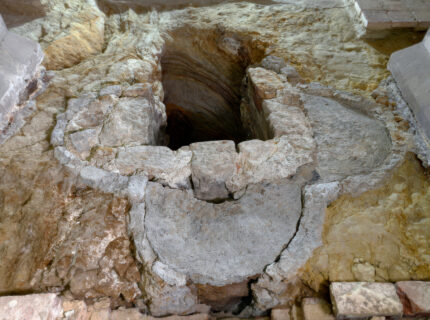 Archaeologists have discovered the remains of a quatrefoil-shaped baptismal font from the 10th century in the collegiate church of St. Servatii in Quedlinburg, Saxony-Anhalt, Germany. It is the oldest quatrefoil baptismal font north of the Alps, and was likely used in the baptism of Ottonian dynasty rulers and family members.
Archaeologists have discovered the remains of a quatrefoil-shaped baptismal font from the 10th century in the collegiate church of St. Servatii in Quedlinburg, Saxony-Anhalt, Germany. It is the oldest quatrefoil baptismal font north of the Alps, and was likely used in the baptism of Ottonian dynasty rulers and family members.
The base of the font emerged in an excavation of the crypt of the church where members of the Ottonian dynasty, kings of Germany and Holy Roman Emperors (919-1024), were buried. Parts of the crypt predate the current collegiate church which was built in the 11th-12th century, and archaeologists with the State Office for Monument Preservation and Archeology of Saxony-Anhalt (LDA) have been exploring the 10th century crypt to research, document, stabilize and preserve the structures underground built in the earliest period of development of the church.
The quatrefoil shape was cut into the sandstone in the center of the room. Its walls are lined with plaster, fragments of an earlier floor used as bedding for the font.
The room in which the baptismal font originally stood must have been the lay room of a sacred building. It is ruled out that there was a palatium (prestigious residential building) on site at this time. The baptismal font belonged to a church and also dates from the oldest decades of the Stiftsberg’s medieval history in the Ottonian period, about which little is known so far.
Although the places and dates of death of members of the ruling families are mentioned more frequently in contemporary written sources, information on baptism has actually not survived. This means that the present archaeological find is also an extremely rare structural evidence of the sacrament of baptism, which is important in Christianity and promises the hope of salvation. According to the Roman-Germanic pontifical in the 10th century, unlike today, baptism took place once a year, on Holy Saturday, as a collective baptism of infants or small children by immersion. The candidates for baptism were immersed in the water in the shape of a cross, in the present case in the direction of the quatrefoils, with their heads facing first to the east, then to the north and finally to the south. The baptismal formula “I baptize you in the name of God the Father, the Son and the Holy Spirit” was spoken. The ceremony was carried out by candlelight and incense and was accompanied by liturgical songs and litanies. A few days later, on the Saturday before White Sunday (the first Sunday after Easter), the baptismal garment was finally removed again and the water was drained from the pool.
It is conceivable that Duke Henry I of Bavaria (born around 922, died in 955), who attempted to kill his brother, King Otto the Great, in an attack in Quedlinburg at Easter in 941, was baptized at the
uncovered location. Mathilde (born 955, died 999), the daughter of Emperor Otto the Great and Empress Adelheid and the first abbess of Quedlinburg Abbey, as well as Adelheid I (born 977; died 1044 in Quedlinburg), the next abbess and daughter of the imperial couple, could also be here Otto II and the Byzantine Theophanu received the first and fundamental sacrament at this point.
Mathilde, born in 955 and died in 999, not only was baptized in the crypt, but was buried there too. Her lead coffin with a gabled roof is in the crypt next to the coffins of her grandparents, including her grandmother and namesake who founded the abbey.